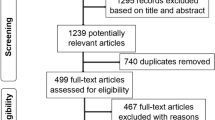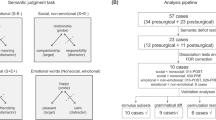Abstract
Natural languages are rife with words that describe feelings, introspective states, and social constructs (e.g., liberty, persuasion) that cannot be directly observed through the senses. Effective communication demands linguistic competence with such abstract words. In clinical neurological settings, abstract words are especially vulnerable to the effects of stroke and neurodegenerative conditions such as Alzheimer’s disease. A parallel literature in cognitive neuroscience suggests that abstract and concrete words are at least partially neuroanatomically dissociable. Much remains to be learned about the nature of lexical-semantic deficits of abstract words and how best to promote their recovery. Here, we review contemporary theoretical approaches to abstract-concrete word representation with an aim toward contextualizing patient-based dissociations for abstract words. We then describe a burgeoning treatment approach for targeting abstract words and suggest a number of potential strategies for future interventions. We argue that a deeper understanding of is essential for informing language rehabilitation.

Similar content being viewed by others
References
Papers of particular interest, published recently, have been highlighted as: • Of importance
Foster Wallace D. Infinite Jest. USA: Little, Brown & Co; 1996.
Wise Brown M. Goodnight Moon. USA: Harper & Brothers; 1947.
Reilly J, Kean J. Formal distinctiveness of high- and low-imageability nouns: analyses and theoretical implications. Cogn Sci. 2007;31(1):157–68.
Coltheart M. Deep dyslexia is right-hemisphere reading. Brain Lang. 2000;71(2):299–309.
Jefferies E, Sage K, Ralph MA. Do deep dyslexia, dysphasia and dysgraphia share a common phonological impairment? Neuropsychologia. 2007;45(7):1553–70.
Martin N, Saffran EM. A computational account of deep dysphasia: evidence from a single case study. Brain Lang. 1992;43(2):240–74.
Plaut DC, Shallice T. Deep dyslexia: a case study of connectionist neuropsychology. Cogn Neuropsychol. 1993;10(5):377–500.
Franklin S, Howard D, Patterson K. Abstract word anomia. Cogn Neuropsychol. 1995;12(5):549–66.
Franklin S, Howard D, Patterson K. Abstract word meaning deafness. Cogn Neuropsychol. 1994;11(1):1–34.
Paivio A. Dual coding theory, word abstractness, and emotion: a critical review of Kousta et al. (2011) J Exp Psychol Gen. 2013;142(1):282–7.
Paivio A. Intelligence, dual coding theory, and the brain. Intelligence. 2014;47:141–58.
Jones GV. Deep dyslexia, imageability, and ease of predication. Brain Lang. 1985;24(1):1–19.
Franklin S. Dissociations in auditory word comprehension; evidence from nine fluent aphasic patients. Aphasiology. 1989;3(3):189–207.
Grodzinsky Y, Santi A. The battle for Broca’s region. Trends Cogn Sci. 2008;12(12):474–80.
Nadeau SE, Gonzalez Rothi LJ, Crosson B. Aphasia and language: theory to practice. New York, NY: Guilford Press; 2000.
Breedin SD, Saffran EM, Coslett HB. Reversal of the concreteness effect in a patient with semantic dementia. Cogn Neuropsychol. 1994;11(6):617–60.
Papagno C, Capasso R, Miceli G. Reversed concreteness effect for nouns in a subject with semantic dementia. Neuropsychologia. 2009;47(4):1138–48.
Reilly J, Peelle JE, Grossman M. A unitary semantics account of reverse concreteness effects in semantic dementia. Brain Lang. 2007;103:248–9.
Warrington EK, McCarthy R. Category specific access dysphasia. Brain. 1983;106(Pt 4):859–78.
Gorno-Tempini ML et al. Classification of primary progressive aphasia and its variants. Neurology. 2011;76(11):1006–14.
Snowden JS, Goulding PJ, Neary D. Semantic dementia: a form of circumscribed cerebral atrophy. Behav Neurol. 1989;2(3):167–82.
Hoffman P. The meaning of ‘life’ and other abstract words: Insights from neuropsychology. J Neuropsychol. 2015. Hoffman provides a comprehensive review of current theoretical perspectives regarding how processing abstract words differs from that of concrete processing. Hoffman further reviews evidence for neuroanatomical correlates and dissociations by integrating insights from patients with language disorders with evidence from functional imaging of neurotypical adults.
Hoffman P, Lambon Ralph MA. Reverse concreteness effects are not a typical feature of semantic dementia: evidence for the hub-and-spoke model of conceptual representation. Cereb Cortex. 2011;21(9):2103–12.
Yi HA, Moore P, Grossman M. Reversal of the concreteness effect for verbs in patients with semantic dementia. Neuropsychology. 2007;21(1):9–19.
Bonner MF et al. Reversal of the concreteness effect in semantic dementia. Cogn Neuropsychol. 2009;26(6):568–79.
Cousins KA et al. Cognitive and anatomic double dissociation in the representation of concrete and abstract words in semantic variant and behavioral variant frontotemporal degeneration. Neuropsychologia. 2016;84:244–51.
Jefferies E et al. Comprehension of concrete and abstract words in semantic dementia. Neuropsychology. 2009;23(4):492–9.
Hoffman P, Jones RW, Lambon Ralph MA. Be concrete to be comprehended: consistent imageability effects in semantic dementia for nouns, verbs, synonyms and associates. Cortex. 2013;49(5):1206–18.
Bird H et al. The rise and fall of frequency and imageability: noun and verb production in semantic dementia. Brain Lang. 2000;73(1):17–49.
Barsalou LW. Grounded cognition. Annu Rev Psychol. 2008;59(1):617–45.
Vigliocco G et al. The neural representation of abstract words: the role of emotion. Cereb Cortex. 2014;24(7):1767–77.
Gallese V, Lakoff G. The Brain’s concepts: the role of the sensory-motor system in conceptual knowledge. Cogn Neuropsychol. 2005;22(3):455–79.
Crutch SJ et al. Abstract conceptual feature ratings: the role of emotion, magnitude, and other cognitive domains in the organization of abstract conceptual knowledge. Front Hum Neurosci. 2013;7:186.
Troche J, Crutch S, Reilly J. Clustering, hierarchical organization, and the topography of abstract and concrete nouns. Front Psychol. 2014;5:360.
Reilly J, et al. Linking somatic and symbolic representation in semantic memory: The Dynamic Multilevel Reactivation framework. Psychonomic Bulletin & Review. 2016.
Crutch SJ, Ridha BH, Warrington EK. The different frameworks underlying abstract and concrete knowledge: evidence from a bilingual patient with a semantic refractory access dysphasia. Neurocase. 2006;12(3):151–63.
Crutch SJ, Warrington EK. Abstract and concrete concepts have structurally different representational frameworks. Brain. 2005;128(Pt 3):615–27.
Crutch SJ, Warrington EK. The differential dependence of abstract and concrete words upon associative and similarity-based information: complementary semantic interference and facilitation effects. Cogn Neuropsychol. 2010;27(1):46–71.
Warrington EK, Shallice T. Semantic access dyslexia. Brain. 1979;102(1):43–63.
Cree GS, McRae K. Analyzing the factors underlying the structure and computation of the meaning of chipmunk, cherry, chisel, cheese, and cello (and many other such concrete nouns). J Exp Psychol Gen. 2003;132(2):163–201.
Schwartz MF et al. Neuroanatomical dissociation for taxonomic and thematic knowledge in the human brain. Proc Natl Acad Sci U S A. 2011;108(20):8520–4.
Seckin M et al. Am I looking at a cat or a dog? Gaze in the semantic variant of primary progressive aphasia is subject to excessive taxonomic capture. J Neurolinguistics. 2016;37:68–81.
Farah MJ, McClelland JL. A computational model of semantic memory impairment: modality specificity and emergent category specificity. J Exp Psychol Gen. 1991;120(4):339–57.
Flanagan KJ et al. Alzheimer’s disease is associated with distinctive semantic feature loss. Neuropsychologia. 2013;51(10):2016–25.
Garrard P et al. Semantic feature knowledge and picture naming in dementia of Alzheimer’s type: a new approach. Brain Lang. 2005;93(1):79–94.
Reilly J et al. Anomia as a marker of distinct semantic memory impairments in Alzheimer’s disease and semantic dementia. Neuropsychology. 2011;25(4):413–26.
Woollams AM et al. Anomia: a doubly typical signature of semantic dementia. Neuropsychologia. 2008;46(10):2503–14.
Lambon Ralph MA et al. No right to speak? The relationship between object naming and semantic impairment: neuropsychological evidence and a computational model. J Cogn Neurosci. 2001;13(3):341–56.
Reilly J, Peelle JE. Effects of semantic impairment on language processing in semantic dementia. Semin Speech Lang. 2008;29(1):32–43.
Schwanenflugel PJ, Akin C, Luh WM. Context availability and the recall of abstract and concrete words. Mem Cogn. 1992;20(1):96–104.
Schwanenflugel PJ, Shoben EJ. Differential context effects in the comprehension of abstract and concrete verbal materials. J Exp Psychol Learn Mem Cogn. 1983;9(1):82–102.
Schwanenflugel PJ, Stowe RW. Context availability and the processing of abstract and concrete words in sentences. Read Res Q. 1989;24(1):114–26.
Hoffman P, Lambon Ralph MA, Rogers TT. Semantic diversity: a measure of semantic ambiguity based on variability in the contextual usage of words. Behav Res Methods. 2013;45(3):718–30.
Landauer TK, Dumais ST. A solution to Plato’s problem: the latent semantic analysis theory of acquisition, induction, and representation of knowledge. Psychol Rev. 1997;104(2):211–40.
Jefferies E, Lambon Ralph MA. Semantic impairment in stroke aphasia versus semantic dementia: a case-series comparison. Brain. 2006;129(8):2132–47.
Thompson-Schill SL. Neuroimaging studies of semantic memory: inferring “how” from “where”. Neuropsychologia. 2003;41(3):280–92.
Binder JR et al. Where is the semantic system? A critical review and meta-analysis of 120 functional neuroimaging studies. Cereb Cortex. 2009;19(12):2767–96.
Wang J et al. Neural representation of abstract and concrete concepts: a meta-analysis of neuroimaging studies. Hum Brain Mapp. 2010;31(10):1459–68.
Boyle M. Semantic feature analysis treatment for anomia in two fluent aphasia syndromes. Am J Speech-Lang Pathol. 2004;13(3):236–49.
Reilly J. How to constrain and maintain a lexicon for the treatment of progressive semantic naming deficits: principles of item selection for formal semantic therapy. Neuropsychol Rehabil. 2016;26(1):126–56.
Kiran S, Sandberg C, Abbott K. Treatment for lexical retrieval using abstract and concrete words in persons with aphasia: effect of complexity. Aphasiology. 2009;23(7):835–53.
Sandberg C, Kiran S. How justice can affect jury: training abstract words promotes generalisation to concrete words in patients with aphasia. Neuropsychol Rehabil. 2014;24(5):738–69. Sandberg and Kiran describe a promising approach to the treatment of abstract word knowledge. Modest improvement were reported in ten of twelve persons with post-stroke aphasia. 8 patients also generalized to concrete words. The authors also briefly speculate on the mechanisms of treatment effects in relation to a subset of cognitive theories of abstract word processing.
Kiran S, Thompson CK. The role of semantic complexity in treatment of naming deficits: training semantic categories in fluent aphasia by controlling exemplar typicality. J Speech lang Hear Res JSLHR. 2003;46(4):773–87.
Locke J. Of abstract and concrete terms, in an essay concerning human understanding (Book 3: of Words). Urie: Glasgow; 1759.
Coltheart M. The MRC psycholinguistic database. Q J Exp Psychol Sec A. 1981;33(4):497–505.
Acknowledgments
J. Reilly is funded by a US Public Health Service Grant R01 (DC013063) to study language treatment for aphasia.
Author information
Authors and Affiliations
Corresponding author
Ethics declarations
Conflict of Interest
The authors declare that they have no conflict of interest.
Human and Animal Rights and Informed Consent
This article does not contain any studies with human or animal subjects performed by any of the authors.
Additional information
This article is part of the Topical Collection on Behavior
Rights and permissions
About this article
Cite this article
Binney, R.J., Zuckerman, B. & Reilly, J. A Neuropsychological Perspective on Abstract Word Representation: From Theory to Treatment of Acquired Language Disorders. Curr Neurol Neurosci Rep 16, 79 (2016). https://doi.org/10.1007/s11910-016-0683-0
Published:
DOI: https://doi.org/10.1007/s11910-016-0683-0




